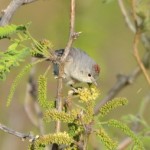 Tucson Audubon is launching an initiative to learn more about Lucy’s Warbler nesting needs as well as study how effective different nestbox designs can be for these charismatic warblers.
Tucson Audubon is launching an initiative to learn more about Lucy’s Warbler nesting needs as well as study how effective different nestbox designs can be for these charismatic warblers.
The Lucy’s Warbler (Oreothlypis luciae) is North America’s smallest cavity nesting bird and is a secondary cavity nester. It is intricately tied to mesquite trees (Prosopis spp) for foraging, so much so that it has previously been called the Mesquite Warbler. In Arizona the primary and largest mesquite is the velvet mesquite (P. velutina) which grows in xero-riparian areas along waterways of all sizes in the Sonoran Desert. On the floodplains of the few remaining perennial rivers and streams, velvet mesquites can form large stands of immense trees forming a dense closed canopy called mesquite bosques. However, the reduction in groundwater levels has resulted in die offs of entire stands of these native trees. Wood from large mesquites is also commercially valuable and results in substantial harvest from the few locations where they still manage to grow. While riparian gallery forests are the poster-child for imperiled habitats in the Sonoran Desert, their associated mesquite bosques are equally imperiled.
 With the reduction in the mesquite-based obligate habitat has come a concurrent reduction in the population of Lucy’s Warblers (LUWA). Part of this reduction is due to overall loss of habitat affecting all parts of the breeding season needs of the warblers, and part is presumed to be due to a specific lack of cavities for nesting. Most secondary cavity nesters, including LUWAs, are presumed to be cavity-limited as their population limiting factor. In 2015 Tucson Audubon (TAS) launched an innovative nestbox project focusing on desert cavity nesting birds. The project includes field experiments of various designs and placements of nestboxes including tracking internal temperatures during the hottest summer days to ensure safety for species using them. Plans and draft best practices are already determined for most species involved. While several designs and placement strategies are being explored for LUWA, preferred box type and placement have not yet been finalized. The effort to create a nestbox design specifically for LUWAs breaks remedies a long-held misconception about LUWA usage of artificial nestboxes.
With the reduction in the mesquite-based obligate habitat has come a concurrent reduction in the population of Lucy’s Warblers (LUWA). Part of this reduction is due to overall loss of habitat affecting all parts of the breeding season needs of the warblers, and part is presumed to be due to a specific lack of cavities for nesting. Most secondary cavity nesters, including LUWAs, are presumed to be cavity-limited as their population limiting factor. In 2015 Tucson Audubon (TAS) launched an innovative nestbox project focusing on desert cavity nesting birds. The project includes field experiments of various designs and placements of nestboxes including tracking internal temperatures during the hottest summer days to ensure safety for species using them. Plans and draft best practices are already determined for most species involved. While several designs and placement strategies are being explored for LUWA, preferred box type and placement have not yet been finalized. The effort to create a nestbox design specifically for LUWAs breaks remedies a long-held misconception about LUWA usage of artificial nestboxes.
This project has been made possible by a grant from the Tracey Aviary Conservation Fund and Tucson Audubon’s ongoing Bringing Birds Home initiative. We would like to thank our partners: Desert Woodcrafters Club who generously donated time, skill and materials to build many of the boxes. Anza Trail Coalition of Arizona, Pima County Flood Control and the Nature Conservancy; all three graciously gave permission to install our 300 trial nestboxes. We would also like to thank all of the volunteer that made this project possible – we couldn’t do this without you!
Different Aspects of the Project
Lucy’s Warbler Nestboxes
There are 20 clusters of the 5 different nestbox trial designs at each of our three major study sites. The three sites are the Anza Trail near Tubac, Tanque Verde Wash at Tanque Verde Loop Rd in east Tucson, and the 7B Ranch near Mammoth, AZ. The boxes are all installed and we need help monitoring the boxes.
Map of Lucy’s Warbler nestbox installation sites: Here is a Google MyMaps of the locations
Monitoring Directions: This pdf explains how to go about monitoring a nestbox route
Sign up to monitor a route: Volunteers can sign up here using this Google Spreadsheet
It is acceptable for more than one person to sign up to monitor each week. The more eyes the better! Take care not to disturb the birds – Do NOT open the boxes!
Lucy’s Warbler Nestbox Monitoring Form – Downloadable paper form to use in the field
Lucy’s Warbler On-line Reporting of Results – Use this Google Survey to tell us what you observed
Lucy’s Warbler Foraging Study
This is an exciting part of the study that we could use lots of help with and you can help with this anywhere and any time you find Lucy’s Warblers hunting for food withing a tree.
Directions For Observing Lucy’s Warbler Foraging: Here is a downloadable directions sheet. (coming soon)
Lucy’s Warbler Foraging Protocol: Download the Protocol here
Data Form SAMPLE: See a sample filled out data form to help explain the protocol
Data form for Foraging Study: Downloadable form here
Guide to identifying Tucson area Mesquites and Palo Verdes: This guide from the University of Arizona is VERY helpful in determining what type of tree your Lucy’s Warbler is foraging within.
Lucy’s Warbler Nest Searching
Protocol and Information for Searching For Lucy’s Warbler Nests: Download Here
Data Form for Recording a Found Nest – both nestbox and natural nest: Download here




